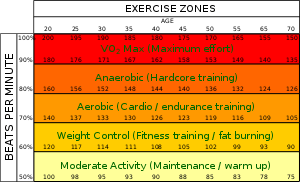Anaerobic exercise
Anaerobic exercise is a type of exercise that breaks down glucose in the body without using oxygen, as anaerobic means “without oxygen”.[1] In practical terms, this means that anaerobic exercise is harder but shorter than aerobic exercise.

The biochemistry of anaerobic exercise involves a process called glycolysis, in which glucose is converted to adenosine triphosphate (ATP), which is the primary source of energy for cellular reactions.[2]
Lactic acid is produced at an increased rate during anaerobic exercise, causing it to build up quickly. The build-up of lactate above the lactate threshold (also called anaerobic threshold) is a major contributor to muscle fatigue.
Anaerobic exercise may be used by personal trainers to help their clients build endurance, muscle strength, and power.[3][4]
Metabolism
Anaerobic metabolism is a natural part of metabolic energy expenditure.[5] Fast twitch muscles (as compared to slow twitch muscles) operate using anaerobic metabolic systems, such that any use of fast twitch muscle fibers leads to an increased anaerobic energy expenditure. Intense exercise lasting upwards of four minutes (e.g. a mile race) may still have considerable anaerobic energy expenditure. An example is High-intensity interval training, an exercise strategy that is performed under anaerobic conditions at intensities that reach an excess of 90% of the maximum heart rate. Anaerobic energy expenditure is difficult to accurately quantify.[6] Some methods estimate the anaerobic component of an exercise by determining the maximum accumulated oxygen deficit or measuring the lactic acid formation in muscle mass.[7][8][9]
In contrast, aerobic exercise includes lower intensity activities performed for longer periods of time. Activities such as walking, jogging, rowing, and cycling require oxygen to generate the energy needed for prolonged exercise (i.e., aerobic energy expenditure). For sports that require repeated short bursts of exercise, the aerobic system acts to replenish energy stores during recovery periods to fuel the next energy burst. Therefore, training strategies for many sports demand that both aerobic and anaerobic systems be developed.

The anaerobic energy systems are:
- The alactic anaerobic system, which consists of high energy phosphates, adenosine triphosphate, and creatine phosphate; and[10]
- The lactic anaerobic system, which features anaerobic glycolysis.[10]
High energy phosphates are stored in limited quantities within muscle cells. Anaerobic glycolysis exclusively uses glucose (and glycogen) as a fuel in the absence of oxygen, or more specifically, when ATP is needed at rates that exceed those provided by aerobic metabolism. The consequence of such rapid glucose breakdown is the formation of lactic acid (or more appropriately, its conjugate base lactate at biological pH levels). Physical activities that last up to about thirty seconds rely primarily on the former ATP-CP phosphagen system. Beyond this time, both aerobic and anaerobic glycolysis-based metabolic systems are utilized.
The by-product of anaerobic glycolysis—lactate—has traditionally been thought to be detrimental to muscle function.[11] However, this appears likely only when lactate levels are very high. Elevated lactate levels are only one of many changes that occur within and around muscle cells during intense exercise that can lead to fatigue. Fatigue, that is muscle failure, is a complex subject that depends on more than just changes to lactate concentration. Energy availability, oxygen delivery, perception to pain, and other psychological factors all contribute to muscular fatigue. Elevated muscle and blood lactate concentrations are a natural consequence of any physical exertion. The effectiveness of anaerobic activity can be improved through training.[12]
Anaerobic exercise also increases an individual's basal metabolic rate (BMR).[13]
Examples
Anaerobic exercise is an intense workout, while aerobic exercise is a long endurance workout. Some examples of anaerobic exercise include sprints, high-intensity interval training (HIIT), and strength training.[14]
References
- "Anaerobic: MedlinePlus Medical Encyclopedia". medlineplus.gov. Retrieved 2020-04-30.
- Cooper, Geoffrey M. (2000). "Metabolic Energy". The Cell: A Molecular Approach (2nd ed.).
- Aouadi, R.; Khalifa, R.; Aouidet, A.; Ben Mansour, A.; Ben Rayana, M.; Mdini, F.; Bahri, S.; Stratton, G. (2011). "Aerobic training programs and glycemic control in diabetic children in relation to exercise frequency". The Journal of Sports Medicine and Physical Fitness. 51 (3): 393–400. PMID 21904277 – via Google Scholar.
- d'Hooge, R.; Hellinckx, T.; Van Laethem, C.; Stegen, S.; De Schepper, J.; Van Aken, S.; Dewolf, D.; Calders, P. (2011). "Influence of combined aerobic and resistance training on metabolic control, cardiovascular fitness and quality of life in adolescents with type 1 diabetes: a randomized controlled trial". Clinical Rehabilitation. 25 (4): 349–359. doi:10.1177/0269215510386254. hdl:1854/LU-1095166. PMID 21112904.
- Scott, Christopher B (June 2005). "Contribution of anaerobic energy expenditure to whole body thermogenesis". Nutrition & Metabolism. 14. 2 (1): 14. doi:10.1186/1743-7075-2-14. PMC 1182393. PMID 15958171.
- Svedahl, Krista; MacIntosh, Brian R (2003). "Anaerobic Threshold: The Concept and Methods of Measurement". Canadian Journal of Applied Physiology. 28 (2): 299–323. doi:10.1139/h03-023. PMID 12825337.
- Medbo, JI; Mohn, AC; Tabata, I; Bahr, R; Vaage, O; Sejersted, OM (January 1988). "Anaerobic capacity determined by maximal accumulated O2 deficit". Journal of Applied Physiology. 64 (1): 50–60. doi:10.1152/jappl.1988.64.1.50. PMID 3356666. S2CID 851358.
- Di Prampero, PE; G. Ferretti (Dec 1, 1999). "The energetics of anaerobic muscle metabolism" (PDF). Respiration Physiology. 118 (2–3): 103–115. CiteSeerX 10.1.1.610.7457. doi:10.1016/s0034-5687(99)00083-3. PMID 10647856. Archived from the original (PDF) on 2011-07-27.
- Scott, Christopher B (2008). A Primer for the Exercise and Nutrition Sciences: Thermodynamics, Bioenergetics, Metabolism. Humana Press. p. 166. ISBN 978-1-60327-382-4.
- Robert Donatelli, Sports-specific Rehabilitation, p. 40, Elsevier, 2007 ISBN 0443066426.
- Westerblad, Håkan (1 February 2002). "Muscle Fatigue: Lactic Acid or Inorganic Phosphate the Major Cause?". Physiology. 17 (1): 17–21. doi:10.1152/physiologyonline.2002.17.1.17. PMID 11821531.
- McMahon, Thomas A (1984). Muscles, Reflexes, and Locomotion. Princeton University Press. pp. 37–51. ISBN 978-0-691-02376-2.
- Scott, Plisk Steven (February 1991). "Anaerobic metabolic conditioning: a brief review of theory, strategy and practical application". Journal of Strength and Conditioning Research. 5 (1): 23–34. Retrieved April 30, 2020.
- "Want to Really Feel the Burn? Try Anaerobic Exercise!". Healthline. Retrieved 2020-02-28.